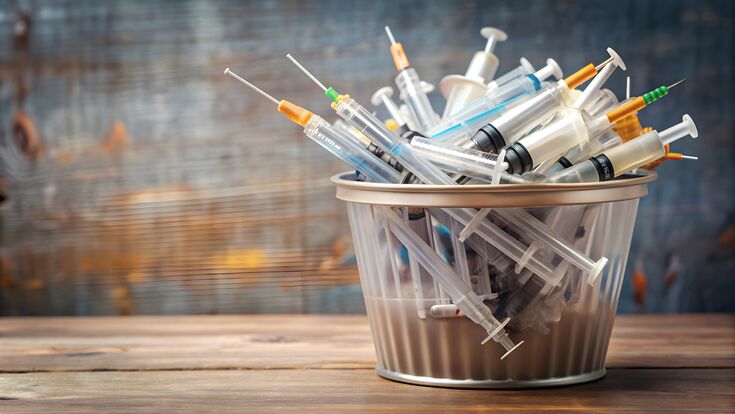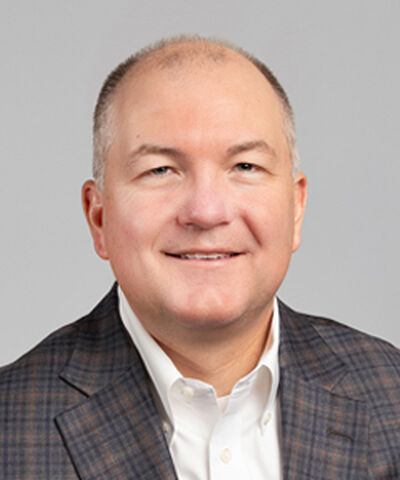Public needle disposal : Q&A: How to properly dispose of medical sharps

What has led to the increase in the number of people using self-injectable medications in public spaces?
The increased use of self-injectable medications has tracked closely with the growing prevalence of chronic diseases, such as diabetes, obesity, allergies, migraines, skin conditions, and arthritis, among other conditions. Individuals often need to inject their medications when they are on-the-go, whether at a restaurant, at an entertainment or hospitality venue, or at the office. A 2023 Stericycle study found that 93% of surveyed organizations have seen equivalent or greater usage of self-injectable medications at their facilities as compared to five years ago. However, with recent demand for self-injected weight loss medications, such as Ozempic and Wegovy, Stericycle has seen increasing market interest and a strong pipeline in sharps collection programs from various enterprise prospects interested in sharps disposal options.
How prevalent is the issue of improper sharps disposal in public restrooms?
More than 3 billion injections are administered outside of healthcare facilities by 9 million medical sharps users, according to a survey from Safe Needle Disposal. When outside of their home, patients typically seek the privacy of a restroom to inject their medication discreetly and safely.
According to responses to a separate survey conducted by Stericycle on National Consumer Diabetes and Access to Care and Sharps Disposal in the Diabetes Community, 75% of customers who consider restroom sharps programs important said they’d use a sharps container in a public space or establishment if they saw one. The issue is that they aren’t widely available. Many of the customers (42%) said that a lack of safe disposal options in public spaces is the biggest challenge they face when discarding sharps. Without proper disposal options, people are left with no choice but to discard sharps in an unsafe manner. Of the survey respondents who have disposed of sharps in a public trash can, 38% said they did so because they had no choice – there were no sharps disposal containers available.
What are some common, yet unsafe, methods people use to dispose of needles in public spaces?
Consumers often lack a safe disposal option for sharps in public spaces. It is not uncommon for staff to find needles discarded in regular trash bins or strewn around the facility in parking lots, on lawns, or dropped on the floor. These practices put the public at risk. Stericycle’s study found that 95% of respondents agreed that occupational health and employee safety are primary drivers of restroom sharps programs adoption or future consideration. Furthermore, the same study found that 81% of respondents felt that spill kits were needed in conjunction with restroom sharps programs to pick up loose needles around the facility.

What are the risks associated with improper disposal of needles in public restrooms for both the public and janitorial staff?
Unlike sharps disposal in clinical settings, which are typically regulated and must follow stringent rules, policies, and procedures, there are limited policies or guidance for disposing of used sharps in at-home or public spaces. As a result, there is a meaningful risk of accidental needlestick injuries when sharps are improperly disposed of in municipal waste streams. Sanitation workers can get stuck and exposed to dangerous, transmissible infections, including hepatitis B and C, and HIV.
From disposal to transportation to treatment, when organizations place sharps containers in their facilities’ restrooms and work with a medical waste management partner, the waste management process is properly handled from end-to-end. This ensures that sharps are safely and compliantly disposed of – protecting staff, the public, and the environment.
Are there better disposal solutions available?
As a leading provider of compliance-based solutions, Stericycle continues to innovate and find solutions for organizations and individuals to safely manage their sharps and other regulated medical waste.
The SafeDrop™ Restroom Sharps Disposal Program is one of Stericycle's Safe Community Solutions aimed at creating safe and healthy environments. With the convenient self-service option, business leaders are provided with a sharps mail-back kit containing everything needed to collect sharps. Once full, personnel can swap out and package the containers, then ship them using the prepaid USPS return box.
This step is crucial as some businesses may buy sharps containers but throw them into the regular trash, which can still pose a risk to those that manage the waste. With auto-replenish options, like the one Stericycle offers, business leaders don’t have to think twice about their sharps disposal containers and can seamlessly mail back the full receptables and receive a replacement.
What steps can public facilities take to improve the safe disposal of needles and protect their staff and patrons?
Implementing compliant sharps disposal strategies is crucial to mitigating risks associated with consumer-generated sharps in public restrooms. Key strategies include:
- Installation of Sharps Containers: Securely mount puncture-resistant sharps containers to restroom walls. They should be placed in an area that is easily accessible and prominently displayed. This ensures individuals are aware of their presence and will dispose of a used sharp in the container as opposed to the regular trash.
- Awareness and Sustainability Campaigns: Build public awareness on safe sharps disposal. Inform individuals that secure and compliant sharps disposal options are available and educate the public on the dangers of improper disposal.
- Team Training: Team members should be made aware of the restroom sharps program and instructed on how to check the containers for fullness and how to use the mail back program. Furthermore, team members should be trained on how to use spill kits for loose needles. They should also be made aware of OSHA guidelines on bloodborne pathogen exposure.
Why is it crucial for public spaces like airports, offices, and restaurants to have proper sharps disposal containers?
People who need to self-administer medications must do so whether there is a sharps container available or not. To help protect staff and the public from potential needlestick injuries, organizations should work to provide an integrated and seamless option for sharps disposal by taking this approach.
Millions of people attend class at college campuses, spend a working day in their office, and dine in restaurants. With a rise in the use of self-injectable medications, it’s crucial for public spaces to offer safe and secure sharps disposal options. The FDA recommends proper disposal programs, but it’s up to business leaders to put them in action.


